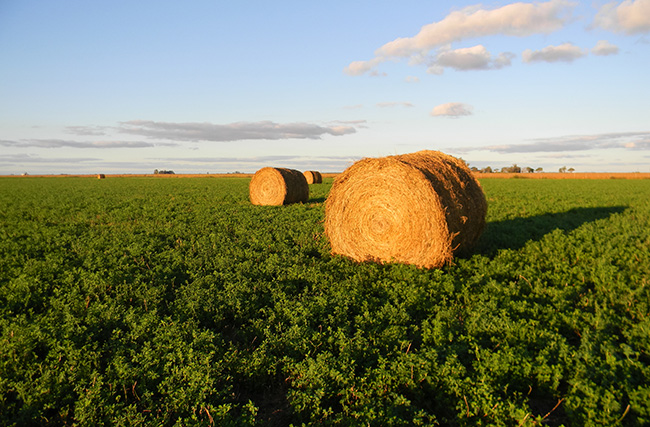 By Dan Keppen, Family Farm Alliance Executive Director
By Dan Keppen, Family Farm Alliance Executive Director
Never in my wildest dreams as a much younger man would I have thought that I would someday spend so much of my professional time defending the production of alfalfa.
I remember my senior year in high school, in northern California’s Lassen County, where many of my friends were from ranching families. Most of them spent a lot of their spare time in the summer cutting, baling and stacking hay.
I was not a rancher. I was a skinny kid who liked music from the 60’s. My only direct experience with alfalfa was in the hippy-owned restaurant I worked at, where the locally famous “Veggie Pizza” was actually topped with fresh alfalfa sprouts!
In recent years, after over three decades in the Western water policy arena, alfalfa matters have consumed much of my time. The Family Farm Alliance membership encompasses most of the “Reclamation West” – those arid and semi-arid states located West of the 100th Meridian.
That includes all seven Colorado River Basin states.
The mainstream media in the past two years has been obsessed with the amount of water that goes to producing alfalfa and other important forage crops in the West. The Colorado River right now is understandably a favorite topic of environmental journalists, as state, federal and tribal decision-makers are scrambling to negotiate a long-term river operating agreement to replace the current one that expires in 2026.
Over the past two years, we’ve witnessed a steady stream of media coverage, essentially carrying a similar message: Growing less hay is the only way to keep the Colorado River’s water system from collapsing.
Some journalists love going after crops that use lots of water. As many of you well know, almond growers in California’s Central Valley were subjected to a merciless multi-year “one almond uses one gallon of water” campaign during the last “unprecedented” drought that hit the Golden State in the last decade.
Guess what? Years later, Central Valley farmers still grow them because consumers around the globe love almonds and consume them in mass quantities for their great taste and dense nutritional punch.

As Western farmers struggle to find adequate water supplies, competing interests are pressuring the federal government to cut the water supply farmers are using to grow our food, including alfalfa, which is a foundational food chain crop.
Alfalfa has received a bad rap in recent years, often due to misinformation.
In reality, alfalfa is important to rural communities, and it is grown throughout the West for good reasons.
With the growing disconnect between the consumers, farmers, and the agricultural processes that sustain the world, it is clear there is a need to bridge this knowledge gap and enlighten the public about the significance of farm water in our food production – including alfalfa and forage crops.
That’s why the Family Farm Alliance has developed “ALFALFA 101” – a new webpage to help the public, policy makers and journalists better understand the rest of the story about alfalfa and forage production in the Colorado River Basin and other parts of the American West.
This new resource features facts, reports, opinion pieces and other information generated by the Alliance, academia, and our allies throughout the West.
Our recent attempts to “tell the other side” of the alfalfa story have been received with praise from some and bemusement by others.
The manager of a New Mexico land trust recently reached out and thanked us for pushing back on the attacks, and explained that the much-maligned crop is actually beautifully described in the Land of Enchantment’s state song:
“Fields full of sweet alfalfa, richest perfumes bestow, State of the apple blossoms, is Nuevo México.”
On the other hand, “The Land Desk” – a newsletter produced out of the Four Corners region – last year referred to me personally as a “noted alfalfaphile”.
It’s been rewarding to see Western partners working with scientists to gather and share data to counter alfalfa’s bad rap. Alfalfa is resilient, drought-tolerant, and economically viable. And it’s a critical part of our food chain – much more than just a topping on pizza!
Yep. Alfalfa is definitely a big part of my life these days.

Earlier this year, one of our Washington state members produced baseball caps emblazoned with the words “Make Alfalfa Great Again” on the front. These were a hot item at our annual conference last February in Reno, and one hat was made for me that had “Alfalfaphile” spelled out on the back.
I find myself stopping to take pictures of fields of recently cut hay and breathing in that sweet smell of freshly cut alfalfa.
And, a few months ago, I jumped out of my truck at a stop light in Klamath Falls and took a picture of a ranching woman’s pickup truck license plates that read “HAYMAMA”.
The “Land Desk” may be on to something.




